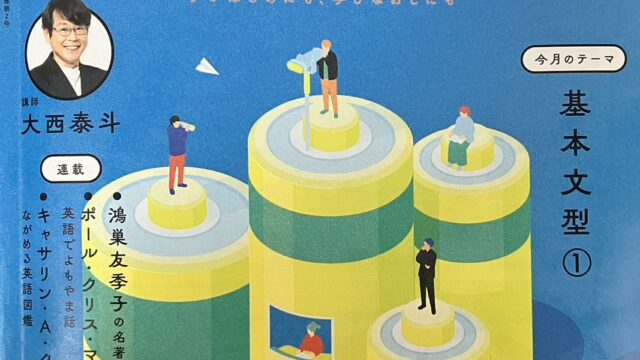May 16 Thursday, 2024
Lesson 29 基本文型 自動型 – 基礎
☆Words & Phrases
She is learning some new techniques.
**can’t wait to do:
I can’t wait to hear her play later.
**improve:
You may be surprised. She has improved a lot.
It is a chocolate cake from Vienna again. – Thank you so much, Ms. Stravinsky! You really like it there.
※You really like it there. のニュアンス
O: Hey David, could you explain the nuance of this sentence?
D: Ah! “You like it there” is a little different from “You like Vienna.” It means she likes to be in Vienna.
R: That’s right. So, the situation is you really like it. Where? In Vienna! So, “there.”
How very nice!
それはすばらしい
☆Grammar and Vocabulary
She has improved a lot.
現在完了形(have+過去分詞)のイメージ – 「(今に)迫ってくる」
この文は「彼女が過去にとても上達した」と言っているわけではない。彼女は上達し、今その状態にある、と現在の状況を述べている
You don’t have to do that.
have to のイメージ
have to は「~しなければならない」と訳されるが、助動詞 must とはニュアンスが異なる
must =「しなくちゃだめ」と話し手の主観を述べるのに対し
have to =「しなければならない客観的な必要性」が強く感じられている
いわば have to は「need to」の親玉
そのため not have to と否定すると「~する必要はない」と必要性の否定となり、
must を否定すると「~してはだめ」となる

☆Target Forms
I go to Vienna every year.
自動型(SV)は動詞の後ろに目的語(名詞)がない型
動作対象である目的語がないため、表すのは「単なる動作」。なのでこの文は、単に「行く」という動作となる
Practice
単なる動作を意識しながら I goと言いましょう。to Vienna はその動作がどこに向かうのかを示し、every year は時を表しています。いずれも修飾語で、文型には関わりません
I go
↓
I go to Vienna.
↓
I go to Vienna every year.
① Don’t run here.
→ 目的語のない run は単なる「走る」という動作
② Luna didn’t come to my party.
→ to 以下は come の向かう場所を指し示している
③ They all agreed with me.
→ agree は「同意する」で、単なる「動作」
「~に同意する」としたいときは agree with と with が必要
④ Apologize to her right now.
→ apologize は「謝罪する」という、対象物を含まない単なる「動作」
★Practice
R: Okay everyone. It’s time to practice. Today we will be practicing simple actions. So, as you say the action, then explain how or where or with who. So, ready to go? Repeat after us,
– Don’t run, Don’t run,
– Don’t run here.
D: Okay. Let’s keep going,
– Luna didn’t come, Luna didn’t come
– Luna didn’t come to my party.
R: Keep going,
– They all agreed, They all agreed,
– They all agreed with me.
D: All right. And one more,
– Apologize, Apologize,
– Apologize to her right now.
D: Unlock your potential.
R: Repetition is the key!
D&R: Great work.
☆Grammar in Action
①私たちのパーティーに来ますか?私たちは人々の総数を知る必要があります。
**total number:
②イアンは毎朝走っています。彼はそれが一日のエネルギーを与えてくれると言っています。
**gives him energy:
③私は謝罪しませんよ。その事故は私のせいではありません。私は何も間違ったことはしていません。
**fault:
★Ending
O: Hey David.
D: Huh?
O: Apologize to her right now.
D: No, I will not apologize, she started it!
R: What did I start?
O: You started everything.
D: What didn’t you start?
May 16 Thursday, 2024
Lesson 29 基本文型 自動型 – 基礎
(日本語訳・解説付き)
☆Words & Phrases
She is learning some new techniques.
いくつか新しいテクニックを練習しているんです
※ study と learn の違いは、study は「授業に出る、本を読む、調査をする=勉強・研究する」で、learn は「新しい事実や考えを理解したり、新しい技術を身につけたりする」です。使い分けられるといいですね!
**can’t wait to do: ~したくてたまらない、~するのを待ちきれない
I can’t wait to hear her play later.
あとであの子の演奏を聞くのが楽しみです
※ I can’t wait(待ちきれない)とは言えるけど、その後ろに「何が待ちきれないのか?」を to不定詞で加えられるようにしておきましょう!
**improve: 上達する
You may be surprised. She has improved a lot.
驚かれるかもしれませんよ。ずいぶん上達しましたからね
It is a chocolate cake from Vienna again. – Thank you so much, Ms. Stravinsky! You really like it there.
今回もウィーンのチョコレートケーキです – ストラヴィンスキー先生、本当にありがとうございます!先生はウィーンにいるのがとても好きなんですね
※You really like it there. のニュアンス
O: Hey David, could you explain the nuance of this sentence?
D: Ah! “You like it there” is a little different from “You like Vienna.” It means she likes to be in Vienna.
R: That’s right. So, the situation is you really like it. Where? In Vienna! So, “there.”
How very nice!
それはすばらしい
※ very は、感嘆文 How nice! を強調しています
☆Grammar and Vocabulary
She has improved a lot.
彼女はとても上達しています
現在完了形(have+過去分詞)のイメージ – 「(今に)迫ってくる」
この文は「彼女が過去にとても上達した」と言っているわけではない。彼女は上達し、今その状態にある、と現在の状況を述べている
You don’t have to do that.
そんなことをする必要はありません
have to のイメージ
have to は「~しなければならない」と訳されるが、助動詞 must とはニュアンスが異なる
must =「しなくちゃだめ」と話し手の主観を述べるのに対し
have to =「しなければならない客観的な必要性」が強く感じられている
いわば have to は「need to」の親玉
そのため not have to と否定すると「~する必要はない」と必要性の否定となり、
must を否定すると「~してはだめ」となる

☆Target Forms
I go to Vienna every year.
私は毎年、ウィーンに行きます
自動型(SV)は動詞の後ろに目的語(名詞)がない型
動作対象である目的語がないため、表すのは「単なる動作」。なのでこの文は、単に「行く」という動作となる
Practice
単なる動作を意識しながら I goと言いましょう。to Vienna はその動作がどこに向かうのかを示し、every year は時を表しています。いずれも修飾語で、文型には関わりません
I go
↓
I go to Vienna.
↓
I go to Vienna every year.
① Don’t run here.
ここで走るな
→ 目的語のない run は単なる「走る」という動作
② Luna didn’t come to my party.
ルナは僕のパーティーには来ませんでした
→ to 以下は come の向かう場所を指し示している
③ They all agreed with me.
彼らはみんな私に賛同しました
→ agree は「同意する」で、単なる「動作」
「~に同意する」としたいときは agree with と with が必要
④ Apologize to her right now.
今すぐ彼女に謝りなさい
→ apologize は「謝罪する」という、対象物を含まない単なる「動作」
★Practice
R: Okay everyone. It’s time to practice. Today we will be practicing simple actions. So, as you say the action, then explain how or where or with who. So, ready to go? Repeat after us,
– Don’t run, Don’t run,
– Don’t run here.
D: Okay. Let’s keep going,
– Luna didn’t come, Luna didn’t come
– Luna didn’t come to my party.
R: Keep going,
– They all agreed, They all agreed,
– They all agreed with me.
D: All right. And one more,
– Apologize, Apologize,
– Apologize to her right now.
D: Unlock your potential.
R: Repetition is the key!
D&R: Great work.
☆Grammar in Action
①私たちのパーティーに来ますか?私たちは人々の総数を知る必要があります。
Are you coming to our party? We need to know the total number of people.
**total number: 総数
②イアンは毎朝走っています。彼はそれが一日のエネルギーを与えてくれると言っています。
lan runs every morning. He says it gives him energy for the day.
**gives him energy: 彼に・エネルギーを・与える(授与型 SVOO)
③私は謝罪しませんよ。その事故は私のせいではありません。私は何も間違ったことはしていません。
I will not apologize. The accident wasn’t my fault. I did nothing wrong.
**fault: 欠点・過失
★Ending
O: Hey David.
D: Huh?
O: Apologize to her right now.
D: No, I will not apologize, she started it!
R: What did I start?
O: You started everything.
D: What didn’t you start?
名古屋駅前にあるビジネス英語&仕事での英語雑談力をつけるための「名古屋BEGビジネス英会話ジム」
営業時間:平日 9:00~22:00 土曜日 9:00~19:00(日祝休み)
〒450-0002 愛知県名古屋市中村区名駅2丁目40-16 名駅野村ビル 5階



